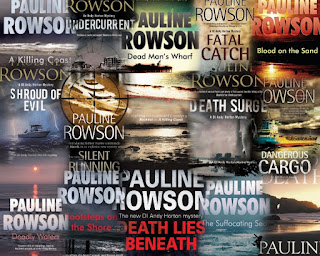How to write a good crime story by Pauline Rowson
I've written a fact sheet primarily for young people interested in entering the CWA'sYoung Crime Writers’ Competition sponsored by CRIMEFEST, an International crime convention held in Britain. It's available on my web site along with details about the competition but I also thought I'd post it here. It might be of interest not only to participants of the crime short story competition but to others who wish to write crime stories or novels.
There are many different types of crime stories from gritty gruesome, cosy comfortable to cops, robbers and gangsters, racy, action-packed thrillers, historical or contemporary, detective or private eye…
Then there is the setting: the city, the sea, countryside, mountains, home or abroad, and the theme – what message are you trying to get across? And whose story is it anyway?
So -
How to write a good crime story by Pauline Rowson
There are many different types of crime stories from gritty gruesome, cosy comfortable to cops, robbers and gangsters, racy, action-packed thrillers, historical or contemporary, detective or private eye…
Then there is the setting: the city, the sea, countryside, mountains, home or abroad, and the theme – what message are you trying to get across? And whose story is it anyway?
So -
- Choose your location
- Choose your type of crime story
- Think about a good theme or message you want to get across in your story
- Choose who is going to be your main character or characters (Note: Don’t have more than two main characters otherwise it will be difficult to write and difficult to read).
- It should be well written with a truly surprising ending.
- You need to plant clues throughout the crime story – not too many but just enough to get the reader thinking.
- One critical piece of information is usually held back until just before the ending.
- The best stories are those that have a theme/message and are firmly based on character.
- Beginning: the main character is introduced immediately, so is the tone and setting and the problem
- Middle: Build the motivation and tension.
- The climax – this is the worst possible moment of the story.
- There should be unities of time, place and action which means that the story should take place over a very short space of time, in the same place and ideally through the main character’s eyes. This results in tight construction and a successful short story.
- a likeable, interesting main character one the reader can have empathy with, one they want to trust, feel his/her pain and disappointments, root for him/her throughout the novel.
- a good supporting cast - the suspects, the villains and the walk-on parts who all need characteristics which are believable even if they are eccentric. The cast must be real to the writer and therefore real to the reader. Don’t choose too many characters in the short story or you will find the story difficult to write and your reader will get confused. Keep it simple.
- a cracking good plot with motives. The plot needs to have twists and turns which will surprise the reader. But the plot and surprises spring from the characters' actions and motivations so we're back once more to creating great characters.
- memorable settings. A sense of place and atmosphere so the reader can see, feel and smell it.
- a mixture of narrative and realistic dialogue
- a strong central theme.What message are you trying to convey in your story?
- a satisfying, surprising ending. All ends neatly tied up, a twist, a sense of leaving the reader wanting to read more, or feeling satisfied.
Plus:
It must be well written. Check your spelling and punctuation.
Hope that helps and good luck to all who enter! I'm looking forward to reading the entries for the South Coast of England.
Closing date is 18 February and entry forms are available through libraries in the UK. Partcipating libraries in the south are: Portsmouth, Southampton, Isle of Wight and West Sussex.
Closing date is 18 February and entry forms are available through libraries in the UK. Partcipating libraries in the south are: Portsmouth, Southampton, Isle of Wight and West Sussex.

Comments